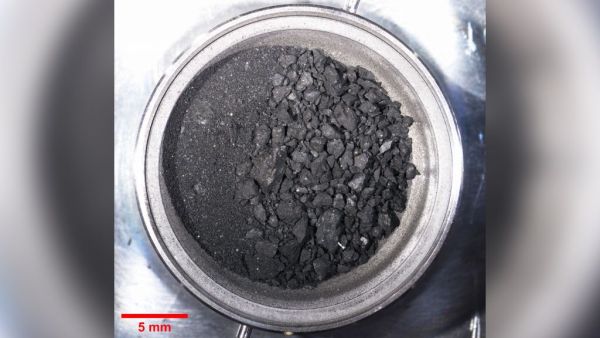'Rubber-ducky' asteroid 200 million miles away holds building blocks of life
Scientists say this means life could be more common than previously thought

For the first time, scientists have found the building blocks for life on an asteroid in space.
Japanese researchers have discovered more than 20 amino acids on the space rock Ryugu, which is more than 200 million miles from Earth.
Scientists made the first-of-its-kind detection by studying samples retrieved from the near-Earth asteroid by the Japan Aerospace Exploration Agency's (JAXA) Hayabusa2 spacecraft, which landed on Ryugu in 2018. In 2019, the spacecraft collected 0.2 ounce (5.4 grams) from the asteroid's surface and subsurface, stowed it in an airtight container and launched it back to Earth on a fine-tuned trajectory.
Related: We may finally know why spinning-top asteroid Ryugu has such a weird shape
Rather than being one large boulder, Ryugu is made up of many small rocks, and the asteroid got its unusual spinning top shape from rapid rotation, scientists believe. As a carbonaceous, or C-type, asteroid, Ryugu contains a large amount of carbon-rich organic matter, much of which likely originated from the same nebula that gave birth to the sun and the planets of the solar system roughly 4.6 billion years ago. Previous sample analysis has also suggested that the asteroid harbors water.

"The Ryugu material is the most primitive material in the solar system we have ever studied," Hisayoshi Yurimoto, a geoscience professor at Hokkaido University and leader of the Hayabusa2 mission's initial chemical analysis team, said while outlining the initial findings at the Lunar and Planetary Science Conference in March.
Unlike the organic molecules found on Earth, the pitch-black asteroid samples, which the scientists found only reflect 2% to 3% of the light that hits them, have not been changed by interactions with Earth's environment, giving them a chemical composition much closer to that of the early solar system.
Sign up for the Live Science daily newsletter now
Get the world’s most fascinating discoveries delivered straight to your inbox.
"We detected various prebiotic organic compounds in the samples, including proteinogenic amino acids, polycyclic aromatic hydrocarbons similar to terrestrial petroleum, and various nitrogen compounds," Hiroshi Naraoka, a planetary scientist at Kyushu University and the leader of the team which looked for organic matter in the samples, said at the conference. "These prebiotic organic molecules can spread throughout the solar system, potentially as interplanetary dust from the Ruygu surface by impact or other causes."
Initially, sample analysis detected 10 amino acid types, but now the number has ballooned to more than 20, according to Japan's education ministry. Amino acids are the fundamental building blocks of all proteins and are indispensable prerequisites for the existence of life on our planet. A 2019 study in the journal Geochimica et Cosmochimica Acta found organic molecules from space in a group of 3.3-billion-year-old rocks discovered in South Africa, raising the possibility that some — if not all — of these life-building molecules first came to Earth on comets and asteroids. The Ryugu findings make the evidence that asteroids carry these molecules even stronger.
"Proving amino acids exist in the subsurface of asteroids increases the likelihood that the compounds arrived on Earth from space," Kensei Kobayashi, a professor emeritus of astrobiology at Yokohama National University, told Kyodo News. This means that amino acids could likely be found on other planets and natural satellites — a clue that "life could have been born in more places in the universe than previously thought," he added.
The researchers are continuing to analyze Ryugu samples, and more data on the asteroid's formation and its composition will become available soon.
And Ryugu is not the only space rock under investigation. In 2021, NASA's OSIRIS-REx spacecraft collected a rock sample from another diamond-shaped asteroid, named Bennu. When the sample returns to Earth in 2023, signs of organic matter contained within it could provide scientists with important clues into the evolution of the solar system and its materials, alongside how life emerged from them.
Originally published on Live Science.

Ben Turner is a U.K. based staff writer at Live Science. He covers physics and astronomy, among other topics like tech and climate change. He graduated from University College London with a degree in particle physics before training as a journalist. When he's not writing, Ben enjoys reading literature, playing the guitar and embarrassing himself with chess.










